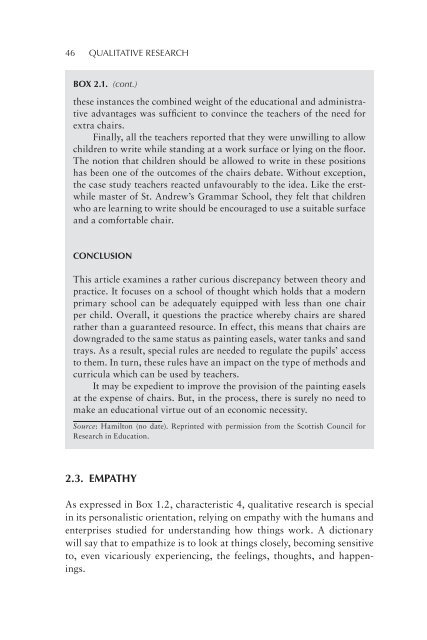How Things Work - Doha Academy of Tertiary Studies
How Things Work - Doha Academy of Tertiary Studies
How Things Work - Doha Academy of Tertiary Studies
Create successful ePaper yourself
Turn your PDF publications into a flip-book with our unique Google optimized e-Paper software.
46 QUaLItatIVe ReSeaRCH<br />
BOX 2.1. (cont.)<br />
these instances the combined weight <strong>of</strong> the educational and administrative<br />
advantages was sufficient to convince the teachers <strong>of</strong> the need for<br />
extra chairs.<br />
Finally, all the teachers reported that they were unwilling to allow<br />
children to write while standing at a work surface or lying on the floor.<br />
The notion that children should be allowed to write in these positions<br />
has been one <strong>of</strong> the outcomes <strong>of</strong> the chairs debate. Without exception,<br />
the case study teachers reacted unfavourably to the idea. Like the erstwhile<br />
master <strong>of</strong> St. Andrew’s Grammar School, they felt that children<br />
who are learning to write should be encouraged to use a suitable surface<br />
and a comfortable chair.<br />
cONclusiON<br />
This article examines a rather curious discrepancy between theory and<br />
practice. It focuses on a school <strong>of</strong> thought which holds that a modern<br />
primary school can be adequately equipped with less than one chair<br />
per child. Overall, it questions the practice whereby chairs are shared<br />
rather than a guaranteed resource. In effect, this means that chairs are<br />
downgraded to the same status as painting easels, water tanks and sand<br />
trays. As a result, special rules are needed to regulate the pupils’ access<br />
to them. In turn, these rules have an impact on the type <strong>of</strong> methods and<br />
curricula which can be used by teachers.<br />
It may be expedient to improve the provision <strong>of</strong> the painting easels<br />
at the expense <strong>of</strong> chairs. But, in the process, there is surely no need to<br />
make an educational virtue out <strong>of</strong> an economic necessity.<br />
Source: Hamilton (no date). Reprinted with permission from the Scottish Council for<br />
Research in Education.<br />
2.3. eMPathY<br />
As expressed in Box 1.2, characteristic 4, qualitative research is special<br />
in its personalistic orientation, relying on empathy with the humans and<br />
enterprises studied for understanding how things work. A dictionary<br />
will say that to empathize is to look at things closely, becoming sensitive<br />
to, even vicariously experiencing, the feelings, thoughts, and happenings.

















